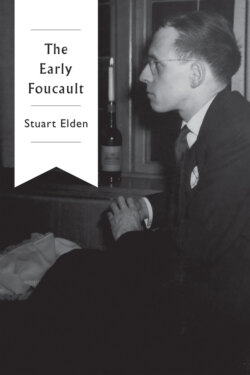Читать книгу The Early Foucault - Stuart Elden - Страница 9
Reading and Writing
ОглавлениеWhile Foucault’s childhood and early schooling will not be discussed here, an anecdote told by his brother, Denys Foucault, is revealing.11 Foucault’s father Paul was a well-known surgeon and medical practitioner, whose Titres et travaux scientifiques was published by a local press the year Foucault was born.12 Foucault’s mother Anne was the daughter of a surgeon and anatomy professor at the University of Poitiers. In their childhood home in Vendeuvre-du-Poitou, there were two libraries – the father’s and the mother’s. His father’s library, in his study, was medical and off-limits; the library of his mother was literary and free to use. If the former would dominate Foucault’s interests through the 1950s and early 1960s, in his work on psychology, madness and medicine, with traces throughout his career; the literary would be a theme to which he often returned. It was in their mother’s library, Denys Foucault suggests, that Michel found Honoré de Balzac, Gustav Flaubert, and classical literature. He wrote on these topics, from an afterword to Flaubert’s Temptation of Saint Anthony to a lecture on that text and Bouvard and Pécuchet, and one on Balzac’s The Search for the Absolute, both given at SUNY Buffalo in 1970.13 His writings in the 1960s for Critique and Tel Quel, on writers including Georges Bataille, Maurice Blanchot, André Breton, Pierre Klossowski, Alain Robbe-Grillet, the Marquis de Sade, and Jules Verne, and of course his book on Raymond Roussel in 1963, all show this enduring literary interest.14
In an interview, Foucault’s partner Daniel Defert says a great deal about his working practices. Foucault apparently worked to a very strict schedule, likening it to a factory job (FMT 215–16/214). He would leave his apartment to reach the library at 9am, often by bicycle, and continue working there until 5.30 or 6pm (FMT 216/215, 232/227). The evenings would be spent on ‘his social and political life’, followed by an hour of reading. This rhythm was not broken at weekends, nor on public holidays, and rarely on vacations. Defert’s recollection is largely of later periods in Foucault’s life – they met in 1960, and much of this relates to the period after Foucault’s return to France from Tunisia. But Foucault had got into these habits early. As a student at the École Normale Supérieure (ENS) he used its library on the rue d’Ulm, as well as the Bibliothèque Sainte-Geneviève situated between the Sorbonne and the Panthéon in the Latin Quarter. From the early 1950s he became an habitué of the Bibliothèque Nationale de France (BNF), then entirely situated on the rue Richelieu near the Louvre and the Palais Royal. This building, with rooms designed by Henri Labrouste, is where the bulk of Foucault’s papers are archived today. Even when based in Uppsala, Warsaw and Hamburg, he would regularly return there on visits to Paris. He resumed working there on a daily basis in the 1960s, apart from while in Tunisia, and this continued until 1979 when he moved to work at the Bibliothèque du Saulchoir.15 As Eribon suggests, the BNF was ‘no doubt the one place in which Foucault spent the most years of his life’.16
While the printed texts and some manuscripts, such as the Clairambault and Joly de Fleury collections, were located in the BNF, Foucault also used other libraries in Paris, including the Bibliothèque historique de la ville de Paris.17 He also worked with materials at the Archives Nationales, and the Bastille archives and the library of the duc de La Vallière at the Bibliothèque de l’Arsenal.18 As Chapter 6 will show, the Carolina Rediviva library at Uppsala University was also important, though not as much as is often said.
While the research was done in the libraries, the writing itself would generally be done at home. Foucault tended to write his books multiple times, in handwritten drafts, which were then developed over time. He would often discard pages and rewrite them anew, rather than cross out material and insert the changes (FMT 225/222, 234–5/229). As the archives show, many of the discarded pages were reused for other purposes, with reading notes or lectures on the reverse, or folded in half to group notes on a theme.19 Defert says that the table on which Foucault wrote History of Madness in Uppsala is still the one in his apartment (FMT 223/220). But while Foucault would write drafts of most of his future books in Paris, he had a habit of finishing them at the family home in Vendeuvre-du-Poitou, where he spent each summer (FMT 223/220).
